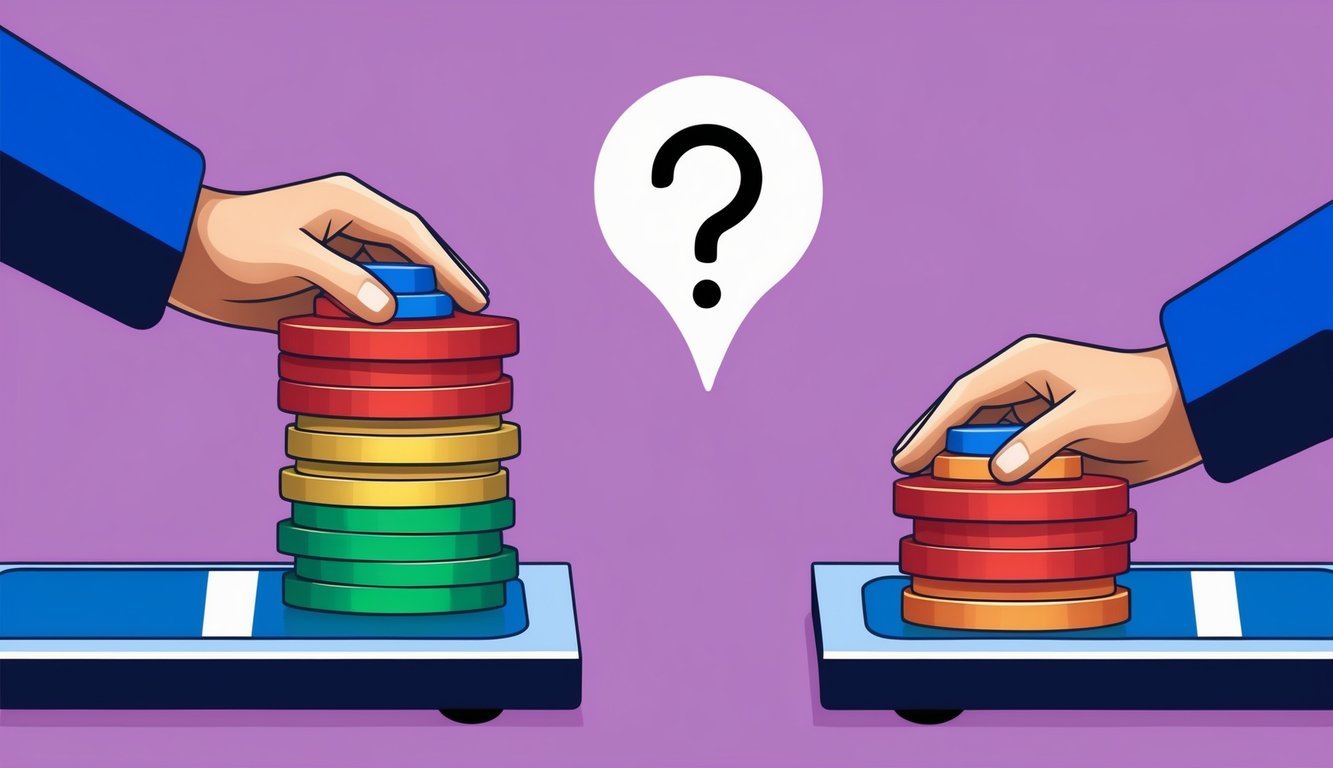Token swapping is a quick way to trade one cryptocurrency for another. You can directly exchange crypto assets by entering the amount and trading pair you want.

This process is becoming more popular as crypto users look for easy ways to move between different coins and tokens. It’s especially useful if you want to try out new projects or take advantage of price differences.
Token swaps can be done on many platforms, from decentralized exchanges to specialized swapping services. Each has its own steps, but the basic idea is the same – you pick what you want to trade and get the new tokens fast.
Key Takeaways
- Token swaps offer a quick way to trade cryptocurrencies without traditional exchanges
- You can swap tokens on various platforms, each with its own simple process
- Understanding token swaps can help you make smart moves in the crypto world
Understanding Token Swaps
Token swaps let you trade one cryptocurrency for another. They’re a quick way to switch between different coins without using regular money. You can do this on exchanges or special platforms.
The Role of Cryptocurrency Exchanges
Crypto exchanges are key players in token swaps. They give you a place to trade your coins. Some big exchanges are Coinbase and Binance.
On these platforms, you can swap popular tokens like Bitcoin for Ethereum. It’s easy to use their websites or apps to make trades.
Exchanges also set the prices for swaps. They look at how much people are buying and selling. This helps decide what your tokens are worth when you trade.
Defining Token Swaps and Their Function
A token swap is when you trade one crypto for another. It’s like swapping baseball cards, but with digital money.
Here’s what token swaps do:
- Let you change between different cryptocurrencies
- Help you get tokens you need for specific blockchain projects
- Allow you to adjust your crypto portfolio quickly
Swaps use smart contracts on blockchains. These are computer programs that make the trade happen automatically.
Types of Token Swaps: Centralized and Decentralized Approaches
You can swap tokens in two main ways: centralized and decentralized.
Centralized swaps:
- Happen on big exchanges like Coinbase
- Are easy to use and often faster
- Require you to trust the exchange with your money
Decentralized swaps:
- Use DeFi platforms like Uniswap
- Let you keep control of your tokens
- Can offer more trading pairs
With decentralized swaps, you connect your wallet directly to a smart contract. This can be safer, but it might be trickier for beginners.
Both types have pros and cons. Centralized is simpler, while decentralized gives you more control. Choose based on what matters most to you: ease or independence.
Executing Token Swaps
Token swaps can be done easily with the right tools and know-how. You’ll need to use decentralized exchanges, work with smart contracts, and keep an eye on fees and risks.
How to Use Decentralized Exchanges (DEXs) for Swapping
To swap tokens on a DEX, you’ll first need a wallet like MetaMask. Connect it to the DEX of your choice. Popular options include Uniswap on Ethereum.
Next, pick the tokens you want to swap. Enter the amount you’re trading. The DEX will show you the exchange rate and estimated output.
Before confirming, double-check all details. Make sure you’re okay with the rates and fees. If everything looks good, approve the transaction in your wallet.
DEXs use liquidity pools and automated market makers (AMMs) to set prices. This means rates can change quickly based on supply and demand.
Smart Contracts: Automating the Swap Process
Smart contracts make token swaps fast and trustless. They’re self-executing programs that run on blockchains like Ethereum.
When you start a swap, the smart contract takes over. It checks if you have enough funds and if the trade is possible. If all checks pass, it moves tokens between wallets automatically.
This process happens in seconds. You don’t need to wait for a middleman to approve anything. Smart contracts also ensure that both sides of the trade happen at the same time.
Be aware that once a smart contract executes, you can’t undo it. Always double-check before confirming.
Managing Risks and Understanding Transaction Fees
Swapping tokens comes with risks. Market volatility can change prices quickly. This might lead to getting fewer tokens than you expected.
Impermanent loss is another risk if you provide liquidity to pools. It happens when token prices change a lot compared to when you added them.
Transaction fees, or “gas” on Ethereum, can be high during busy times. You might pay more in fees than you gain from the swap. Check fee estimates before confirming.
To manage risks:
- Set slippage tolerance to avoid bad rates
- Use reputable DEXs only
- Don’t trade more than you can afford to lose
- Consider waiting for lower network fees
Always keep some ETH in your wallet for gas fees. Without it, you can’t make transactions on the network.
Advanced Concepts in Token Swapping
Token swapping goes beyond basic exchanges. New tech lets you move tokens between blockchains, use big pools of coins, and shift assets to better networks. These tools open up cool ways to trade and invest.
Cross-Chain Swaps and Multi-Token Transactions
Cross-chain swaps let you trade tokens on different blockchains. You can swap Bitcoin for Ethereum tokens without using a centralized exchange. This is great for diversifying your crypto portfolio.
Multi-token transactions let you swap several tokens at once. Instead of doing many trades, you can do one big swap. This saves time and might cost less in fees.
These swaps use special bridges or protocols. They keep your tokens safe while moving them between chains. Popular networks for cross-chain swaps include:
- Polygon
- Arbitrum
- Optimism
- Avalanche
- BNB Chain
Liquidity Pools and Their Impact on the Crypto Ecosystem
Liquidity pools are big pots of tokens that make swapping easy. When you use a decentralized exchange, you’re often trading with these pools.
Here’s how they work:
- People add tokens to the pool
- They earn fees from trades
- This keeps the market liquid
Liquidity pools are changing how we trade crypto. They:
- Make markets more stable
- Let anyone be a market maker
- Support new tokens and projects
But watch out! Some pools can be risky. Always check a pool’s history and size before using it.
Token Migration: Moving Assets Across Blockchains
Token migration means moving your tokens to a new blockchain. This happens when a project upgrades or changes networks. It’s like moving to a better neighborhood for your crypto.
Why migrate?
- Better tech on the new chain
- Faster transactions
- Lower fees
- More features
To migrate your tokens, you usually:
- Send old tokens to a special address
- Get new tokens on the new chain
Be careful with deadlines! If you miss the migration window, you might lose your tokens. Always follow the official steps from the project team.
Migrations can boost innovation. They let projects pick the best blockchain for their needs. This helps the whole crypto world grow and improve.
Frequently Asked Questions

Token swapping can seem complex at first. These common questions will help you understand how it works and what to consider before swapping tokens. One critical aspect to grasp is understanding leveraged tokens, which allow traders to amplify their exposure to price movements in the market. It’s essential to consider the risks associated with these tokens and how they can affect your portfolio over time. By educating yourself and asking the right questions, you’ll be better equipped to navigate the world of token swapping effectively.
How does token swapping actually work in the crypto space?
Token swapping lets you trade one crypto for another directly. You pick the tokens you want to swap and the amount. Then the swap service converts your coins right away. You only pay fees once, making it simple and fast.
What steps should I take to swap tokens on an exchange like Binance?
First, you need to connect your wallet to the exchange. Then choose the tokens you want to swap. Enter how much you want to trade. Check the exchange rate and fees. If it looks good, confirm the swap. The exchange will handle the rest.
Can you explain what a token swap smart contract entails?
A token swap smart contract is a bit of code that makes the swap happen. It checks that you have enough tokens to trade. Then it sends your tokens to the other person and gives you theirs. The contract makes sure everything is fair and happens at the same time.
What’s the difference between token swapping and crypto trading?
Token swapping is faster and simpler than regular trading. With swapping, you trade directly between two tokens. Trading often involves more steps, like selling one token for a common currency, then buying another. Swapping can be cheaper too, since you only pay fees once.
What should I know about token distribution mechanisms in swaps?
Token distribution in swaps can vary. Some swaps use liquidity pools where lots of tokens are stored. Others might use order books like regular exchanges. The method affects how fast your swap happens and what price you get. It’s good to check how a swap service handles this.
What are the risks and benefits of swapping tokens?
Swapping tokens offers benefits such as speed and ease. With it, you can quickly change your crypto portfolio. However, swapping also comes with risks. For instance, price changes can occur during the swap. Some tokens might also be less secure or valuable than others. Always check the tokens and swap service before trading. And don’t swap more than you can afford to lose.





